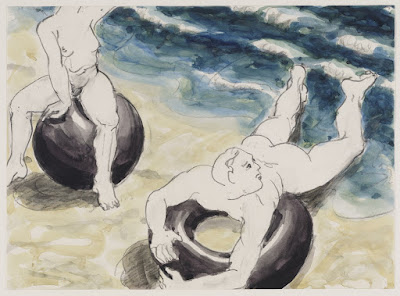 |
| Richard Roland Holst Poster for Lucifer (play by Joost van den Vondel) 1910 lithograph Rijksmuseum, Amsterdam |
 |
| Theo van Hoytema Ape balancing on a Ball ca. 1910 lithograph Rijksmuseum, Amsterdam |
 |
| Theo van Hoytema Barge-Billed Heron in the Rain ca. 1908 lithograph Rijksmuseum, Amsterdam |
 |
| Kees van Dongen Portrait of Kiki de Montparnasse ca. 1922-24 watercolor on paper Museo Thyssen-Bornemisza, Madrid |
 |
| Kees van Dongen Woman with a Fan ca. 1920 lithograph Fine Arts Museums of San Francisco (Achenbach Foundation) |
 |
| Kees van Dongen The Wrestlers before 1933 watercolor and gouache on paper Art Institute of Chicago |
 |
| James Ensor Theater of Masks 1908 oil on canvas Museo Thyssen-Bornemisza, Madrid |
 |
| James Ensor Jardin d'Amour ca. 1925 oil on panel Museo Thyssen-Bornemisza, Madrid |
 |
| Marcel Maeyer Sewer Work at Latem 1975 acrylic on canvas Museum Boijmans Van Beuningen, Rotterdam |
 |
| Marcel Maeyer Fair Tent 1975 acrylic on canvas private collection |
 |
| Marcel Maeyer Fair Tent II 1976 acrylic on canvas Ulster Museum, Belfast |
 |
| Marcel Maeyer Fair Tent ca. 1980 acrylic on canvas private collection |
 |
| Henry Pauw van Wieldrecht Hunting Trophy 1910 photograph Rijksmuseum, Amsterdam |
 |
| J.H. Pleging Faber (Amsterdam) Design for Lace Doily with Butterfly Border ca. 1920-35 drawing (ink on cardboard) Rijksmuseum, Amsterdam |
Filling Station
Oh but it is dirty!
– this little filling station,
oil-soaked, oil-permeated
to a disturbing, over-all
black translucency.
Be careful with that match!
Father wears a dirty,
oil-soaked monkey suit
that cuts him under the arms,
and several quick and saucy
and greasy sons assist him
(it's a family filling station),
all quite thoroughly dirty.
Do they live in the station?
It has a cement porch
behind the pumps, and on it
a set of crushed and grease-
impregnated wickerwork;
on the wicker sofa
a dirty dog, quite comfy.
Some comic books provide
the only note of color –
of certain color. They lie
upon a big dim doily
draping a taboret
(part of the set), beside
a big hirsute begonia.
Why the extraneous plant?
Why the taboret?
Why, oh why, the doily?
(Embroidered in daisy stitch
with marguerites, I think,
and heavy with gray crochet.)
Somebody embroidered the doily.
Somebody waters the plant,
or oils it, maybe. Somebody
arranges the rows of cans
so that they softly say:
esso–so–so–so
to high-strung automobiles.
Somebody loves us all.
– Elizabeth Bishop (1965)
 |
| Thomas Bernstein Bathers on a Beach 1992 watercolor Teylers Museum, Haarlem |